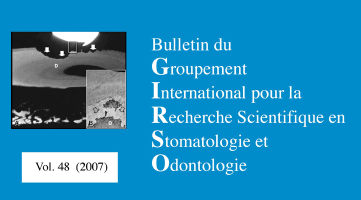Titanium miniscrews under continuous loading in a Pig jaw: a histological study
Abstract
There is increasing interest in using titanium miniscrews for orthodontic anchorage. This experimental study aimed to evaluate the histological aspect of mandibular bone around miniscrews subjected to continuous forces in a pig. Three miniscrews were inserted on both sides of a pig mandible. Four weeks after implantation, a coil spring was fixed between two of the right miniscrews, while the left miniscrews remained unloaded. The pig was sacrificed nine weeks after implantation. Two right screws were lost during this period: one loaded screw and the unloaded one. Microradiographic and histological analysis revealed bone apposition in contact of about 1/3 of the unloaded screw surface, whereas the other 2/3 were surrounded by mesenchymal tissue. At distance of the implant, bone underwent important remodeling. No direct screw-bone contact was found around the loaded screw. Bone apposition and resorption were visible at distance of the screw, respectively on its traction and compression sides. In this preliminary study, osseointegration of the unloaded screw appeared more successful than that of the loaded ones. Further studies should be conducted during a longer follow-up period in order to define the degree of minimal osseointegration associated with an efficient anchorage.Downloads
Published
Issue
Section
License
I hereby certify that the authors of the above manuscript have all:
1. Conceived, planned, and performed the work leading to the report, or interpreted the evidence presented, or both;
2. Written the report or reviewed successive versions and shared in their revisions; and
3. Approved the final version.
Further, I certify that:
1. This work has not been published elsewhere and is not under revision in another journal;
2. Humane procedures have been followed in the treatment of experimental animals (if applicable);
3. Investigations in humans was done in accordance with the ethical standards of the responsible committee on human experimentation or with the Helsinki Declaration (if applicable).
4. This paper has been carefully read by a native English speaker who is familiar with the field of work (this applies to authors who are not fluent in English); and
5. The copyright of the article is transferred from the authors to the Bulletin du Groupement International pour la Recherche Scientifique en Stomatologie et Odontologie upon acceptance of the manuscript.



